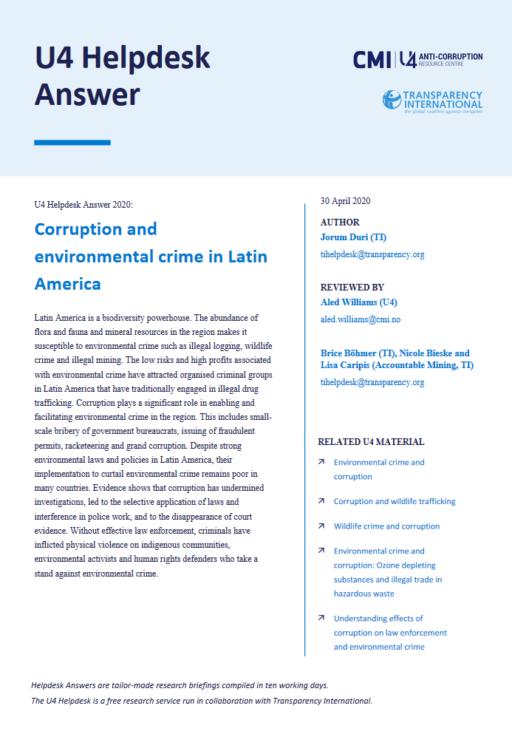
This Anti-Corruption Helpdesk brief was produced in response to a query from a U4 Partner Agency. The U4 Helpdesk is operated by Transparency International in collaboration with the U4 Anti-Corruption Resource Centre based at the Chr. Michelsen Institute.
Query
Please provide an overview of corruption and environmental crime in Latin America, with an emphasis on wildlife crime, illegal trade in hazardous waste, and the impact of corruption on law enforcement bodies tasked with policing environmental crime.
Summary
Latin America is a biodiversity powerhouse. The abundance of flora and fauna and mineral resources in the region makes it susceptible to environmental crime such as illegal logging, wildlife crime and illegal mining. The low risks and high profits associated with environmental crime have attracted organised criminal groups in Latin America that have traditionally engaged in illegal drug trafficking. Corruption plays a significant role in enabling and facilitating environmental crime in the region. This includes small-scale bribery of government bureaucrats, issuing of fraudulent permits, racketeering and grand corruption. Despite strong environmental laws and policies in Latin America, their implementation to curtail environmental crime remains poor in many countries. Evidence shows that corruption has undermined investigations, led to the selective application of laws and interference in police work, and to the disappearance of court evidence. Without effective law enforcement, criminals have inflicted physical violence on indigenous communities, environmental activists and human rights defenders who take a stand against environmental crime.
Contents
- Corruption and the environmental sector
- Background
- Risks of corruption in public environmental administration
- Overview of corruption and environmental crime in Latin America
- Illegal logging
- Wildlife crime
- Dumping and illegal trade in hazardous waste
- Illegal mining
- Impact of corruption on law enforcement bodies
- References
Main points
- The Amazon, which stretches across nine Latin American countries, is a primary target for environmental crime in the region.
- Widespread corruption, at different stages and levels in the environmental sector, enables the commission of environmental crime in the region.
- Organized criminal groups in Latin America that have traditionally engaged in illegal drug trafficking are now increasingly getting involved in the most lucrative activities of environmental crime. Lower risks and huge profits in the environmental sector attract criminal networks.
- Despite strong environmental laws and policies, their implementation to curtail environmental crime remains poor in many Latin American countries. Evidence shows that corruption undermines investigations, led to the selective application of laws and interference in police work, and the disappearance of court evidence.
- In 2018, Latin America recorded the highest number of deaths of environmental activists or defenders, who are targets of powerful environmental criminals.
Caveat
This paper focuses on four types of environmental crime: illegal logging; wildlife crime; dumping and illegal trade in hazardous waste; and illegal mining.
Authors
Jorum Duri (TI), [email protected]
Reviewers:
Aled Williams (U4), [email protected], Brice Böhmer (TI), Nicole Bieske and Lisa Caripis (Accountable Mining, TI), [email protected]
Date
03/09/2020

